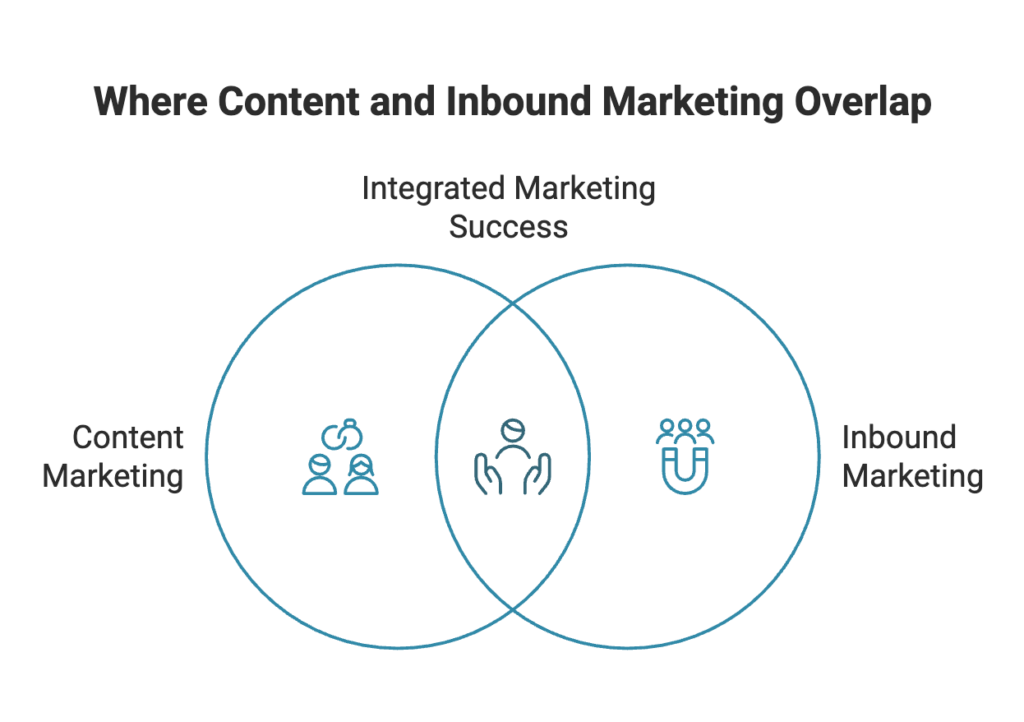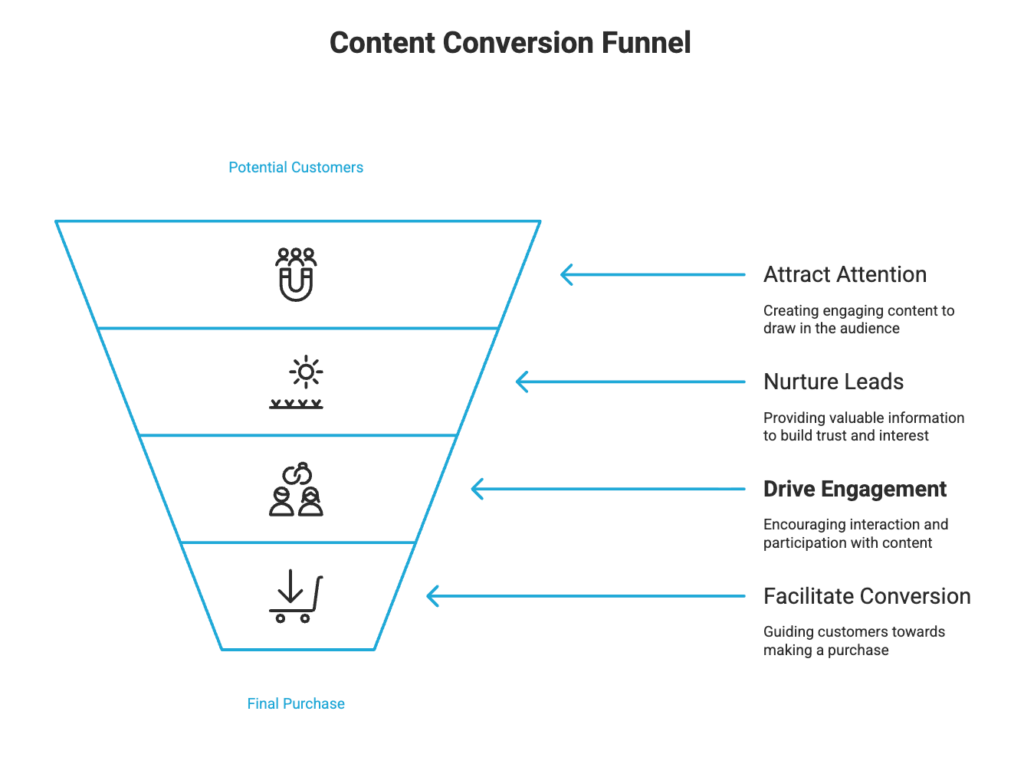Content Marketing vs. Inbound Marketing: How They Work Together
Content marketing is part of inbound marketing. Inbound focuses on drawing in and connecting with customers.

What is content marketing? What is inbound marketing? And when should you use one over the other?
The answer might surprise you: Content marketing is actually a type of inbound marketing. They aren’t separate strategies. Instead, one can support and enhance the other.
Inbound marketing refers to a methodology that attracts customers, luring them in with valuable content and experiences tailored specifically to their needs and likes. It’s the opposite of outbound marketing, which relies on broad, untargeted ads that reach anyone and everyone.
Content marketing can be a part of an outbound marketing strategy, but it functions much better as part of an inbound marketing strategy. When done right, it builds authority, boosts engagement, and strengthens customer loyalty.
Key Takeaways:
- Content marketing is a tool within the inbound marketing approach.
- Inbound marketing focuses on attracting and connecting with customers through personalised experiences.
- Effective inbound and content marketing builds authority, engagement, and customer loyalty.
Maximise your content’s impact and crush your inbound goals. Start with Convertri today.
What is inbound marketing?
Inbound marketing makes it quicker for customers to find you through social media, search engines, and word of mouth because your content naturally provides answers that they’re looking for.
Think of it this way: whenever you think of a question or how to solve a problem, you Google it if there are no experts nearby. If you’re dealing with a complex problem or one that happens again and again, you’ll likely make more searches. The more often you get answers that come from one specific person or company, the more you’ll trust them in the future to help you.
In essence, inbound marketing is the practice of promoting yourself by providing value to new, existing, and potential customers. There are many types of inbound marketing, including, but not limited to:
- Blogs
- Newsletters
- Social media (such as Facebook, Twitter, Pinterest)
- Ebooks
- Online courses
- SEO website text
- Webinars
- Videos (tutorials, how-tos)
It might help to think of inbound strategy as fishing. You cast a net in a good spot in the lake and wait for fish to take the bait – in other words, a passive activity. Outbound marketing, on the other hand, is like hunting. You go out and search for a target and, when acquired, try for a good shot. It’s an active way of marketing.

Inbound > outbound
You might think that an active hunting strategy would be better—and it’s true that outbound marketing, such as Google Ads, emails, and television spots, still has a place. But the truth is, not many people enjoy being sold to.
(Ad-blockers are a thing for a reason.)
After all, have you ever been annoyed by an ad? Probably. And that was most likely because it was outbound – in other words, pushing at you rather than pulling you in.
Inbound marketing relies on the principle of giving first and taking later. People often feel obligated to say thank you to people who have helped them, even if it’s just with a like or comment.
What is content marketing?
Used with care, content marketing can be a powerful part of any inbound marketing strategy. But what do we mean by “content”?
Content is, arguably, anything educational or entertaining you create and share that doesn’t contain an overt sales message. It can contain a call to action at the end, but it’s primary goal is not to sell, sell, sell: it’s to share a message.
The most common types of content marketing are:
- Infographics
- Blog content
- Podcasts
- Videos
- Social media posts
As you can probably guess, there’s a lot of overlap here. Infographics can be shared to blogs and social media, and podcasts can be syndicated as videos, and vice versa. That’s why it’s important to have a wide-ranging, yet targeted, content marketing strategy so you’re making the most out of everything you post.
Make every piece of content count with Convertri’s powerful marketing tools.
Content marketing vs. inbound marketing
| Dimension | Content Marketing | Inbound Marketing |
| Goal | Build brand awareness, educate the target audience, nurture leads | Attract, engage, and convert prospects into customers |
| Scope | Focused on creating and distributing valuable content (blogs, videos, ebooks, social posts) | Broader strategy including content, SEO, social media, email, lead nurturing, and conversion tactics |
| Primary Tools | Blog platforms, social media, video platforms, and content management systems | CRM, digital marketing automation, email platforms, landing pages, analytics tools |
| Metrics / KPIs | Page views, engagement, shares, time on page, and content downloads | Lead generation, conversion rates, ROI, customer acquisition, lifecycle metrics |
| Approach | Storytelling and value-driven content to educate and build trust | End-to-end journey mapping to guide prospects from awareness to decision |
| Audience Interaction | Primarily one-to-many; builds awareness and thought leadership | Multi-touch, personalized engagement to convert and retain customers |
Key takeaway: Content marketing fuels inbound marketing. You can’t do inbound effectively without consistent, high-quality content, but content alone doesn’t guarantee conversions—it needs the inbound framework to guide prospects through the funnel.
How inbound and content marketing work together
Content marketing and inbound marketing are most effective when they operate in tandem. Content fuels the inbound funnel, attracting the right audience, generating leads, and nurturing them toward conversion.

Key ways content supports inbound marketing:
- Lead Generation: Blog posts, eBooks, and videos capture interest and encourage sign-ups.
- Lead Nurturing: Email sequences, webinars, and case studies educate prospects and build trust.
- Conversion: Targeted content guides leads through decision-making toward purchase.
Example Workflows:
- Blog → Lead Magnet → Email Sequence → Conversion
- A blog post addresses a pain point → visitors download a free guide → enter an email nurture sequence → eventually schedule a consultation.
- Video → Landing Page → Webinar → Product Demo
- A short video introduces a solution → leads land on a dedicated page → register for a webinar → attend a demo and become a qualified lead.
These workflows demonstrate how content drives inbound efforts, creating a seamless path from discovery to conversion.
Your content deserves to work harder. Get Convertri and unlock smarter marketing automation.
Blogging as marketing
It’s 2025, and blogs still account for the vast majority of content marketing out there. Gone are the heady days of Blogspot sites with animated banners and custom cursors (sadly) – now, blogging is high tech, slick, and done extremely well by corporations.
The fact is, businesses that use blogs receive 97% more links to their websites and, in turn, have 434 percent more indexed pages for the SERPs. Who’d have thought that regularly publishing on topical issues would get you to the top of Google faster?
That’s why blogging is a no-brainer – and it’s why blogging is also extremely cost-effective for small businesses on a tight budget. Blogging levels the playing field. If the blog of a cleaning product giant doesn’t contain more useful tidying and scrubbing tips than the single mom from down the road, she’s going to get more views.
Content marketing can include ebooks, reports and whitepapers.
A word on ethics
Content marketing is most effective when used strictly for good. Rather than blogging about how your newest product will change lives, you should be writing about topics related to your products or services. You should be writing to solve problems, help others, and share good messages. After more than a hundred years of being marketed to as we know it, audiences have fine-tuned their shill-o-meter to detect even the most well-intentioned of sales pitches – and if they don’t like it, will turn off.
Sharing great content is the single best way to get you seen as an expert. Once you’re seen to have authority, your trust will increase and so will your audience’s faith in you.
Add genuine impact by adding something new and valuable, above and beyond what your competitors offer. After all, your readers want to know how you can help solve their problem, not what everyone else has already said.
Now that you understand how content fuels inbound marketing, put your strategy into action. Use Convertri funnels or landing pages to capture leads and convert them into loyal customers.
From content creation to lead conversion, Convertri makes inbound marketing simple—start now!
What do you think about content marketing? Do you use it in your own strategy? How has it worked for you? Let us know in the comments!





